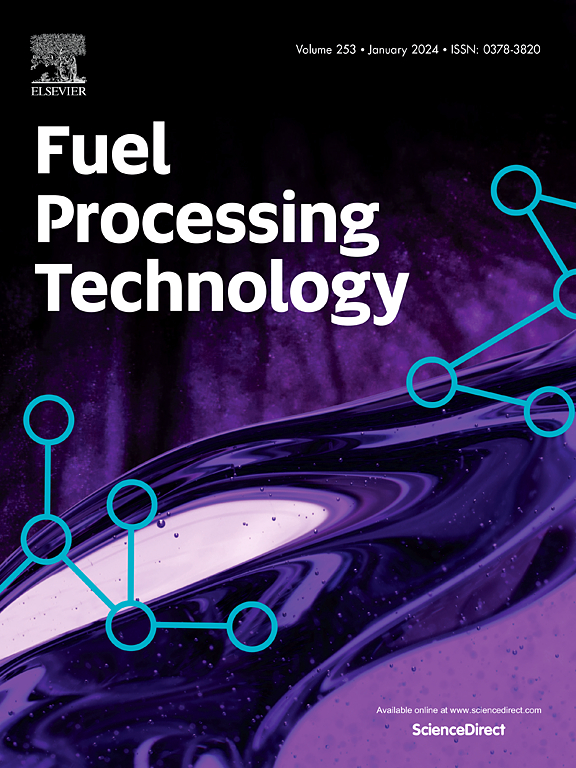太阳能驱动的化学循环燃烧:为脱碳能源部门提供低影响碳排放和可持续制氢的途径
IF 7.2
2区 工程技术
Q1 CHEMISTRY, APPLIED
引用次数: 0
摘要
本研究研究了一种太阳能驱动的化学环燃烧(CLC)系统,用于可持续制氢。通过灵敏度分析建立并优化了高温CLC模型,结果表明,增加铁蒸汽反应堆压力(最优:40 bar)和蒸汽流量可使氢气产量提高28%,而由于反应平衡约束,更高的太阳能铁反应堆压力可使产量降低19%。太阳能-CLC混合系统表现出优异的性能,高温模式产生10500 kmol/h的氢,比低温模式(5348 kmol/h)多96%,比非太阳能CLC多135%。火用分析证实,铁蒸汽反应堆是效率最高的组件(效率为90%),而铁燃料反应堆的损失最高(效率为50%)。设拉子作为最有利的位置,由于其较高的太阳辐照度(123.2比88.6 kWh/m2 DNI),比阿瓦士(最不合适的城市)需要的镜子少32%。由于白昼时间延长,恰巴哈尔的产氢量最高(11,803千摩尔/天)。相变材料存储分析表明,恰巴哈尔所需的存储模块比设拉子少40%。太阳能-CLC集成在效率和减排方面都优于传统CLC,高温模型在高辐照区域是最佳的。研究结果为在脱碳能源部门部署可再生氢动力系统提供了可行的见解。本文章由计算机程序翻译,如有差异,请以英文原文为准。
Solar-driven chemical looping combustion: A pathway to low-impact carbon emission and sustainable hydrogen generation for a decarbonized energy sector
This study investigates a solar-driven chemical looping combustion (CLC) system for sustainable hydrogen production. A high-temperature CLC model was developed and optimized through sensitivity analysis, revealing that increasing iron steam reactor pressure (optimal: 40 bar) and steam flow rate enhances hydrogen production by up to 28 %, while higher solar‑iron reactor pressure reduces output by 19 % due to reaction equilibrium constraints. The solar-CLC hybrid system demonstrated superior performance, with the high-temperature model producing 10,500 kmol/h of hydrogen—96 % more than the low-temperature model (5348 kmol/h) and 135 % more than non-solar CLC. Exergy analysis confirmed the iron-steam reactor as the most efficient component (90 % efficiency), whereas the iron-fuel reactor exhibited the highest losses (50 % efficiency). Shiraz as the most favorable location, required 32 % fewer mirrors than Ahvaz (the least suitable city) due to its higher solar irradiance (123.2 vs. 88.6 kWh/m2 DNI). Chabahar achieved the highest hydrogen yield (11,803 kmol/day) owing to extended daylight hours. Phase-change material storage analysis showed Chabahar needed 40 % fewer storage modules than Shiraz. Solar-CLC integration outperforms traditional CLC in both efficiency and emissions reduction, with the high-temperature model being optimal for high-irradiance regions. The findings provide actionable insights for deploying renewable-powered hydrogen systems in decarbonizing the energy sector.
求助全文
通过发布文献求助,成功后即可免费获取论文全文。
去求助
来源期刊

Fuel Processing Technology
工程技术-工程:化工
CiteScore
13.20
自引率
9.30%
发文量
398
审稿时长
26 days
期刊介绍:
Fuel Processing Technology (FPT) deals with the scientific and technological aspects of converting fossil and renewable resources to clean fuels, value-added chemicals, fuel-related advanced carbon materials and by-products. In addition to the traditional non-nuclear fossil fuels, biomass and wastes, papers on the integration of renewables such as solar and wind energy and energy storage into the fuel processing processes, as well as papers on the production and conversion of non-carbon-containing fuels such as hydrogen and ammonia, are also welcome. While chemical conversion is emphasized, papers on advanced physical conversion processes are also considered for publication in FPT. Papers on the fundamental aspects of fuel structure and properties will also be considered.
 求助内容:
求助内容: 应助结果提醒方式:
应助结果提醒方式:


